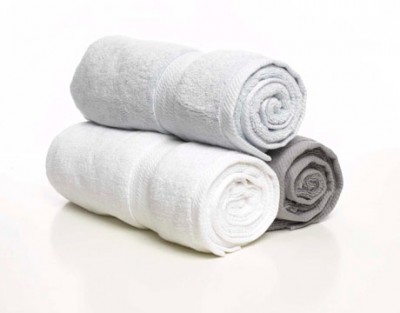
Yes. Towels, sir. I said towels.
What’s the big deal with towels? Well, you’ve got them around, first of all. Or you ought to. A decent stock of linen really amounts to essentially supplies for an ambulance, and yes, I maintain that even if you do use the crinkly disposable paper sheets. Blankets for sure, sheets if you use ’em, and towels. Lots of towels.
Towels are the duct tape of padding-related conundrums. If you can’t do it with a towel, it doesn’t need doing. Other than stopping bleeding, checking your oil, and (I suppose) actual cleaning, most applications involve using them as some sort of padding. But to become a towel samurai, you’ll first need to learn the three basic towel forms: Rolls, pads, and snakes. (Towel supply is a little limited at this exact hour, so I’ve substituted an old bath towel, which I’ll thank you not to abuse.)
The Towelbox
Pads are simply towels folded flat, into squares or rectangles of the desired size, like a napkin. Good for basic flat padding purposes — just make sure you fold intelligently to obtain the size and thickness you need (and don’t be afraid to stack multiple towels together).
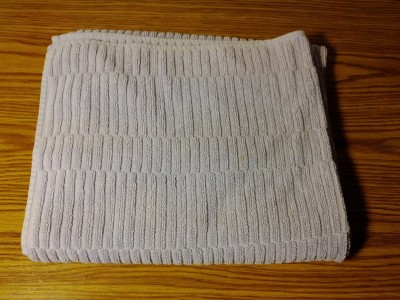
Rolls, on the other hand, are constructed by folding long rectangular pads and then rolling them into fat, tight little cigars, like toilet paper. Great for makeshift pillows, extra-thick padding, and anything requiring bulky structure or space-filling.
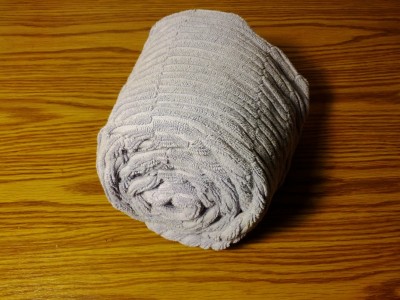
Finally, snakes are towels unfolded to their full length and then twisted (or folded very thin) to make long noodles. You can even tie them end-to-end to make ropes. Great for “lengthwise” padding, makeshift towlines, wrapping around stuff, etc.
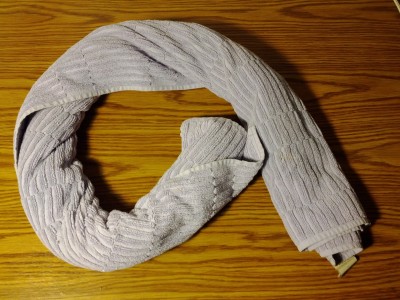
Got it? Good. Now, here’s a few uses for the things beyond just cleaning up your messes.
Padding Voids
You were taught to do this in school, and then you promptly stopped bothering. Shame on you. It takes practice to get good at it, but if you do, you can seriously reduce the physical abuse you’re inflicting on your patients by backboarding them.
Make small rolls to fill the lumbar void, and rectangular pads for thick spaces like between the legs. Blankets may be needed for particularly large areas, which is fine — blankets are just towels on steroids, after all.
Take the time to pad in a similar fashion when applying splints, particularly box-style splints, and you can substantially increase their effectiveness. Works great for scoop stretchers too. Patient with a hip fracture on the ground or in a bed? Scoop them up, and generously pad between and over their legs. Once you secure the straps there should be nowhere to move, and you’ve turned the device into a secure, large-scale lower-body splint with essentially no movement of the limb. Not bad.
Silencing Equipment
We talked about this before — particularly when it comes to backboards, which have a habit of banging around in their enclosures, a towel roll (or if the gap is slim, a thick pad) can be a quick fix to muffle the noise a little.
Head Immobilization
Most services nowadays have gone over to commercial head blocks or headbeds; the days of sandbags (or liters of saline) are sadly over. However, there are still places that use primarily towel rolls, and even if you carry commercial blocks they make a great backup — and we always need backups. Frankly, I think good towel rolls work better than most other methods, too; they compress and mold against the head, making them both comfortable and secure.
Stack together two or three large towels, folded into long rectangles, then roll them together tightly into a thick cylinder about the same length and not much thinner than a human head. Take some tape (I like 2″ cloth tape for this) and tape a couple rings to hold it together — a loop near both ends seems to yield better padding than looping the middle. Make a second roll just like it, and you’ve got headblocks! (The roll depicted is probably a little longer than necessary.)
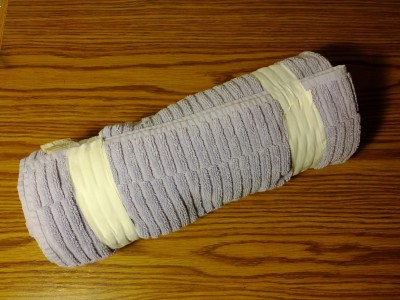
Secure them alongside the patient’s head and tape the same as you would commercial blocks. Just make sure they’re fat enough to provide real support; a single rolled towel, for instance, never seems like enough bulk.
Ghetto Collars
So you sized the patient, you reached for a no-neck C-collar, and it’s too small. Oh, it’s not a matter of neck length; they are indeed neckless. Rather, it’s a question of girth. They’re just too big for the collar to reach around. And sadly, although most rigid cervical collars come in a variety of heights, there are usually no options to size for diameter (pediatric collars may be smaller, but there’s rarely any “bigger” size available). What to do?
Try a towel snake. Using a long towel (or two), twist it into a thick rope and wrap it around the patient’s neck like a scarf. Don’t choke them, but wrap it snugly; most towels seem long enough to circle a typical neck with plenty of overlap, which I leave in the front as a chin support. Slap a little tape across the overlap to more or less secure it, and there you have it — a good-faith attempt at cervical immobilization, not as effective as a rigid collar but far better than nothing. (You can always sit there holding manual immobilization too, I suppose. But remember that the collar is mostly a reminder, and the blocks and straps are doing the majority of the work to actually limit motion.)
We could go on forever about towels, and I don’t even know most of the tricks; this is the sort of thing you figure out gradually over the course of a long career. (Although Christopher Watford did turn us onto towel animals as popularized by Carnival Cruise Lines, and if you can master those you’ll be a big hit at parties.) Thom Dick has a stellar collection of ideas that he writes about in his columns. We’ll probably do a sequel to this eventually, but in the mean time — what are your favorite uses for towels?
I don’t manage an airway without a bunch of towels. Proper head position is key, whether you’re intubating, bagging, or the patient is altered and breathing spontaneously, and a stack o towels is how I make that happen.
Coincidentally, at this very moment I’m working on a post about preoxygenation with a NRB and editing the section on the importance of sniffing position in easing the work of breathing.
AIRWAY! How did I forget? Great one, Vince. But I think we’re due for a good airway post here anyway.
Those of us who are fans of Hitchhiker’s Guide to the Galaxy are well acquainted with the importance of towels. Don’t leave your planet without one!